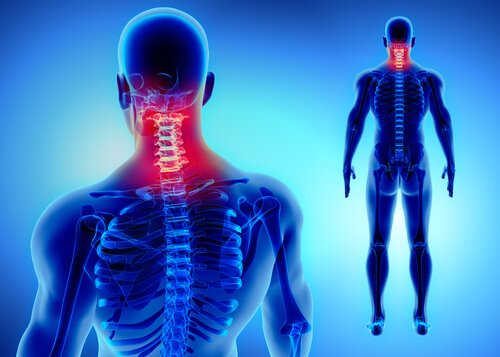Whiplash: Symptoms and Treatment

You’re driving your car and have to brake suddenly. Your head jolts forwards, and it’s not long before you feel an intense pain in your neck that doesn’t go away. This is commonly known as whiplash. In this article, we discuss its symptoms and treatment.
Whiplash is quite a painful condition that can reduce your mobility. It can also spread to other areas of the body. This is why you need to rest after suffering an accident like this. You should also go see a specialist as soon as possible so that they can prescribe the right treatment.
What are the symptoms of whiplash?
Whiplash is usually caused by an abrupt movement of the neck. It can cause the following symptoms:
- Dizziness or vertigo.
- Pain caused by movement of the spine.
- Intense pain in the cervical area that can extend to the head.
It can be caused by:
- Torn ligaments.
- Neck, head, or even back muscle contractures.
The symptoms will vary depending on the patient.

Treatment of whiplash
When we go see a specialist in traumatic injuries such as whiplash, they’ll carefully examine the affected area to see if there are any major injuries. Whiplash can lead to less important conditions, such as post-traumatic pain. However, it can also cause more serious damage, such as disc problems.
Because the injury is usually concentrated in the neck area, one of the first preventive measures will be a cervical collar or neck brace. It’ll reduce your mobility but will also ensure you don’t aggravate the injury. Specialists also usually prescribe pain killers in order to relieve the patient’s pain.
The medication you’ll need will depend on how you’re progressing. Specialists tend to prescribe muscle relaxants and anti-inflammatory medication. Also, due to the sprains that whiplash causes, it’s also advisable to go see a physiotherapist to treat the contracted muscles.
The treatment of whiplash can be complemented with massages to stimulate circulation. In addition, you should make sure to follow an adequate diet since this can help accelerate the healing process.

What to do during your recovery
- You must keep the neck brace on for at least 72 hours.
- The neck brace will immobilize the area and help you avoid making awkward movements. However, you must remember that not moving the area means that it’ll become rather stiff. For that reason, you should only wear the brace for as long as your doctor tells you to.
- It’s also very important to adopt a comfortable and correct posture. This will help align your vertebrae correctly. There are two special movements you need to learn in order to correct both the cervical and lumbar muscles.
- First of all, you should move your jaw backwards until it aligns with the spine. Then, practice forward turning hip movements.
Exercise
- You can start controlled and moderate exercise to help you strengthen the muscles in the affected areas when your doctor tells you. Cardiovascular exercise, such as jogging, isn’t advisable since it can jolt vertebrae.
- It’s advisable to continue seeing your physiotherapist during your recovery process.
- Finally, you can keep taking the medication for as long as your doctor prescribed it for.
You must bear in mind that you may not always feel like you did before the accident. Some injuries will never heal completely, and you have to understand and accept that. Your quality of life may be affected, but you shouldn’t let your injury interfere with your day-to-day life.
This text is provided for informational purposes only and does not replace consultation with a professional. If in doubt, consult your specialist.








